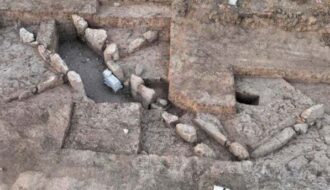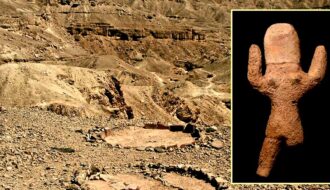2,500-Year-Old Marble Disc: Ancient Ship Protector and Evil Eye Ward Off Discovered
A rare 2,500-year-old marble disc, designed to protect ancient ships and ward off the evil eye, was discovered by a lifeguard diving at sea and handed over to the Israel Antiquities Authority.

A marble disc, dating to the 5th–4th centuries BCE, was found during a dive by lifeguard David Shalom at the Yavne-Yam archaeological site near Palmachim Beach.
“From drawings on pottery, mosaics, and ancient coins, as well as from historical sources from the 5th century BCE, we learn that this design was common on ships’ bows and served to protect against the evil eye and envy, aided navigation, and acted as a pair of eyes looking ahead and warning of danger,” Yaakov Sharvit, Director of the Marine Archaeology Unit at the Israel Antiquities Authority, explained.
This decoration is still common today on modern ships in Portugal, Malta, Greece, and the far east.”
The large white marble disc, 20 cm diameter, is flat on one side and curved on the other, and it has a central cavity with traces of paint appearing as two circles around the center.
It is identified as an eye motif, in Greek “ophtalmoi,” and such discs adorned the bows of ancient warships and merchant vessels. Lead or bronze nails attached the center of the disc to the ship’s hull.
Although this artifact was once common and one would expect to find many similar artifacts, it is, in fact, rare. So far, only four similar ancient items have been discovered in the Mediterranean: two from the wreck of an ancient merchant ship found at the Tektas Burnu site off the western coast of Turkey, between the islands of Samos and Kios, dating to 440–425 BCE, and two on the Mediterranean coast of Israel—one from the Carmel Beach and the other, just discovered, on the Yavneh-Yam coast.
“Yavne-Yam was settled for the first time in the Middle Bronze Age,” Sharvit says, “and was settled down to the Middle Ages. Near the ancient mound, there is a natural sheltered anchorage protected by a rock promontory.”
In water surveys conducted by the Marine Archaeology Unit of the Israel Antiquities Authority since the 1980s, finds from shipwrecked ships testifying to extensive commercial activity at the site were discovered.
These include anchors of various sizes and weights with one to three holes, fishing equipment, lead weights, and stone anchors.
Items used on ships were also found, including a lead cooking oven, grinding stones, stone bowls, fishing tools (bronze fishhooks, lead fishing nets, and lead depth measurement weights), as well as storage jars, amphorae, bowls, and cooking pots dating back to the Late Bronze Age, Persian, Hellenistic, Roman, and Byzantine periods!
Sharvit explains: “Many of the pottery vessels were manufactured in the Levant or the eastern Mediterranean, but some were imported from distant Mediterranean countries.”
The site revealed many Bronze Age finds, including dozens of gold items (earrings, beads, jewelry fragments, ingots, and jewelry industry waste), as well as a Syrian hematite seal.
The finds were scattered in the area where 20 stone anchors, bronze arrowheads, tridents, and two figurines of the god Baal were discovered in the past.
The archaeological finds indicate that the anchorage was in continuous use from the Late Bronze Age down to the medieval period.
Ancient Archaeology




